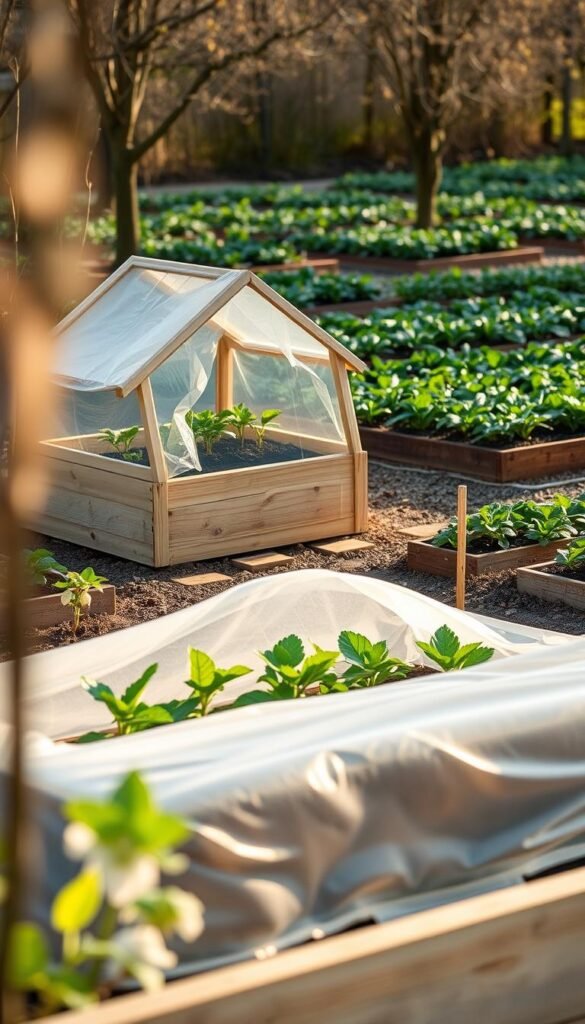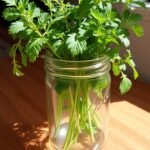What if your backyard could yield crisp greens long after summer fades? Imagine plucking juicy tomatoes weeks earlier than neighbors. With smart tools like protective covers and mini-greenhouses, you’ll stretch your garden’s productivity effortlessly.
These methods shield delicate plants from frost while trapping the sun’s warmth. Experts at Gardener’s Supply note that even basic setups add 4-6 weeks to your harvest calendar. No heavy digging or complex setups required—just strategic placement.
Early spring chills won’t stop you from sowing seeds. Lightweight fabrics guard seedlings against wind, letting them thrive in cooler soil. Come fall, sturdy frames keep crops cozy as temperatures drop. You’ll enjoy fresh veggies when others rely on grocery stores.
This approach isn’t just about surviving winter. It maximizes every ray of heat during transitional months. Your garden becomes a year-round source of nourishment, adapting to nature’s rhythms instead of fighting them.
Ready to transform how you grow food? Let’s explore how these uncomplicated solutions create lasting rewards.
Getting Started with No-Dig Garden Season Extension
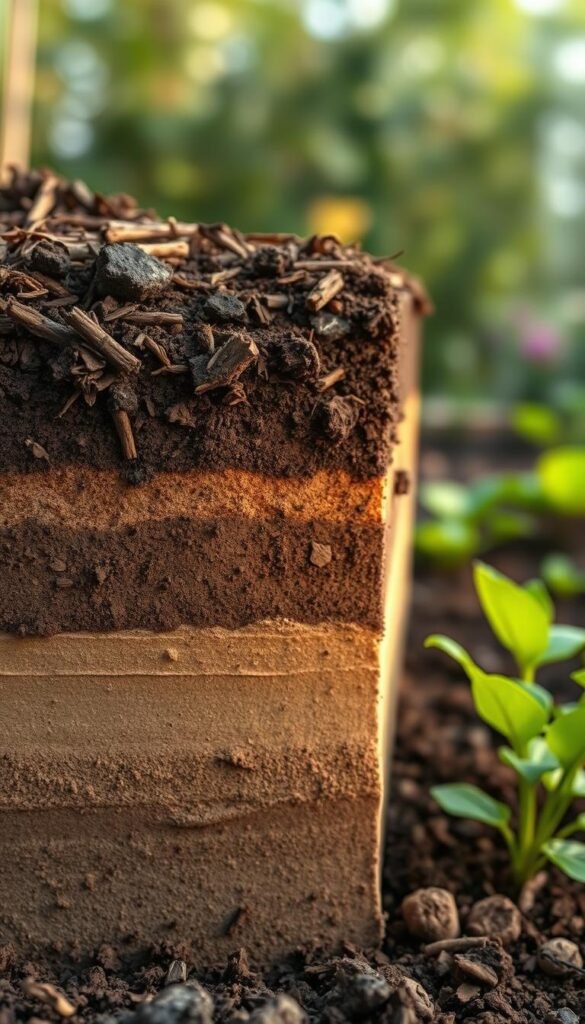
Want fresh spinach in November or snap peas in March? It starts with working with your soil, not against it. By skipping tilling, you preserve underground ecosystems that naturally regulate temperature and moisture—key allies for stretching your harvest.
Understanding No-Dig Principles and Benefits
Layering compost and mulch mimics nature’s way of building fertile ground. Earthworms and microbes thrive when undisturbed, creating air pockets that help plants access nutrients. This method reduces weeding time by up to 70%, according to a University of Vermont study.
Your garden becomes a self-sustaining system. Organic matter breaks down slowly, feeding crops across spring and fall. Lightweight fabric covers then add frost protection without smothering growth.
Essential First Steps for Your Garden
Begin by clearing debris and laying cardboard to suppress weeds. Top it with 3 inches of compost—this becomes your planting bed. For early crops, drape row covers directly over seedlings. They’ll trap warmth while letting air circulate.
Choose cold-hardy plants like kale or radishes for your first attempt. Stagger plantings every two weeks to ensure a steady variety of harvests. Remember: success comes from adapting, not perfecting.
Essential Tools: Row Covers, Cold Frames, and More
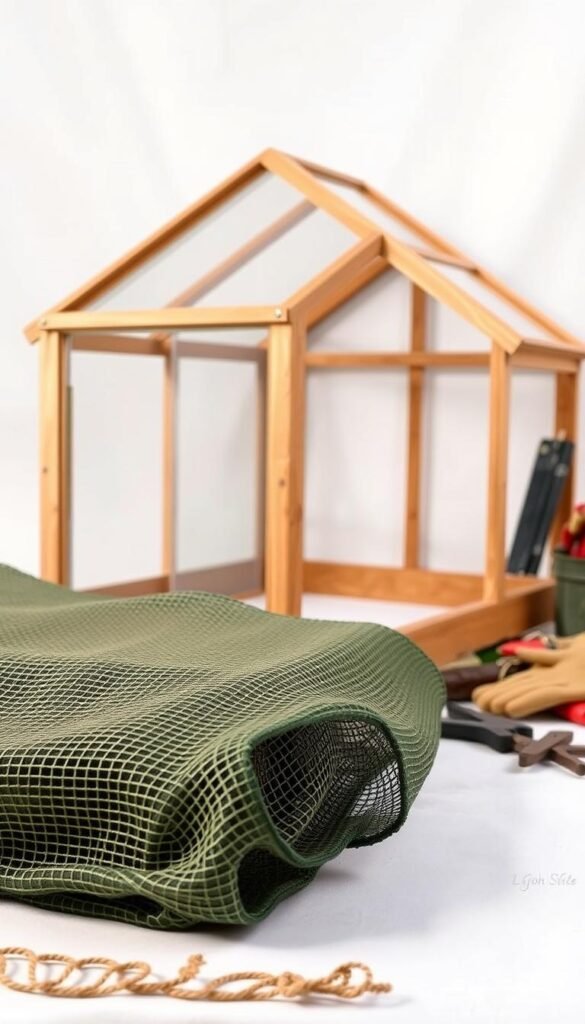
Choosing the right gear can turn your garden into a year-round powerhouse. Protective materials act like a cozy blanket for your plants, blocking frost while letting the sun nourish growth. Whether you’re battling spring chills or fall freezes, durable fabrics and smart designs make all the difference.
How to Choose the Right Materials
Start by matching tools to your climate. Lightweight fabric covers (0.5 oz/sq yd) shield seedlings without blocking light. For heavy frosts, opt for thicker plastic sheets or polycarbonate cold frames. Check UV ratings—materials lasting 5+ seasons save money long-term.
Look for breathable row covers that let air flow but trap warmth. A Cornell study found spun-bonded polyester raises soil temps by 4-8°F, perfect for early crops. Avoid cheap vinyl—it cracks quickly and overheats plants.
Integrating Plastic Mulch and Fabric Covers
Pair black plastic mulch with floating fabric for a one-two punch. The mulch absorbs sunlight, warming soil beneath, while the cover guards against nighttime dips. This combo lets you plant lettuce 3 weeks earlier in spring and harvest kale past Thanksgiving.
For best results, lay mulch 2 weeks before seeding. Drape row covers loosely over hoops to prevent contact with leaves. Open ends during sunny days to prevent greenhouse-like overheating.
| Material | Best Use | Avg. Cost |
|---|---|---|
| Polyethylene Plastic | Soil Warming | $0.12/sq ft |
| Spunbonded Fabric | Frost Protection | $0.25/sq ft |
| Polycarbonate Panels | Cold Frames | $3.50/sq ft |
Extending the Season in No-Dig Gardens: Row Covers and Cold Frames
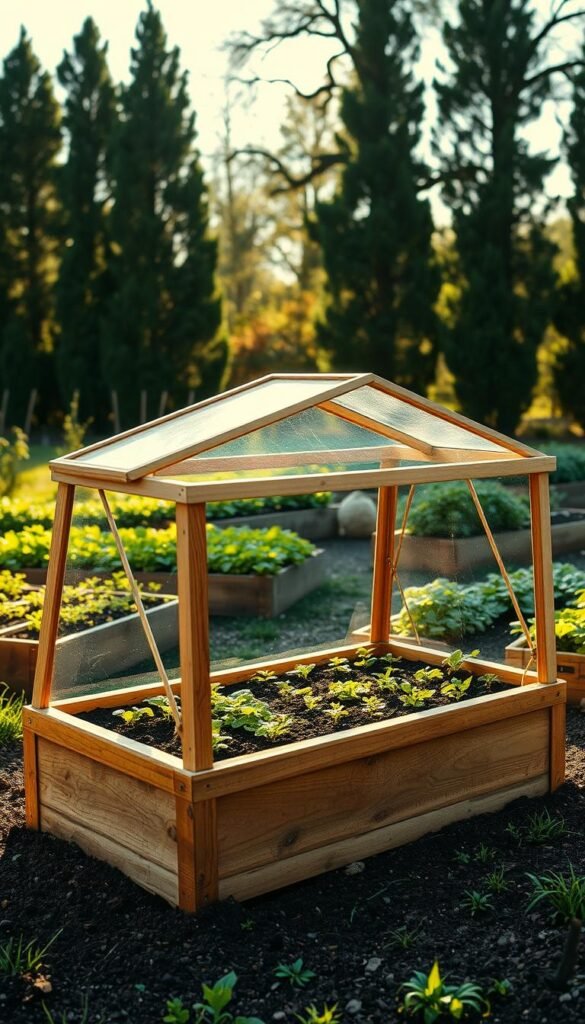
Ever wonder how some gardens thrive while others fade? The secret lies in balancing nature’s rhythms with smart protection. By letting soil ecosystems flourish undisturbed, you create a resilient foundation for crops to outlast unpredictable weather.
Why This Strategy Works for Your Garden
Lightweight row covers act like solar blankets, trapping the sun’s energy during the day. At night, they lock in heat, shielding plants from frost. Gardener’s Supply reports these fabrics maintain soil temperatures 5-10°F above outdoor readings—enough to keep spinach growing through light snow.
Unlike traditional methods, no-dig beds retain moisture and warmth naturally. A Michigan State trial found undisturbed soil under plastic-topped cold frames stayed 8°F warmer than tilled plots. This lets you start seeds earlier and harvest tender greens weeks past first frost.
Breathable materials prevent overheating while blocking wind damage. Open your cover during sunny afternoons to refresh air flow, then close it as dusk cools. You’ll spend less time replanting and more enjoying robust yields.
From kale to carrots, this approach nurtures crops through temperature swings. One Maine gardener harvested carrots in January using just a cold frame and straw insulation. Your growing season isn’t limited by the calendar—it’s shaped by clever design.
Techniques to Shield Your Plants from Frost and Wind
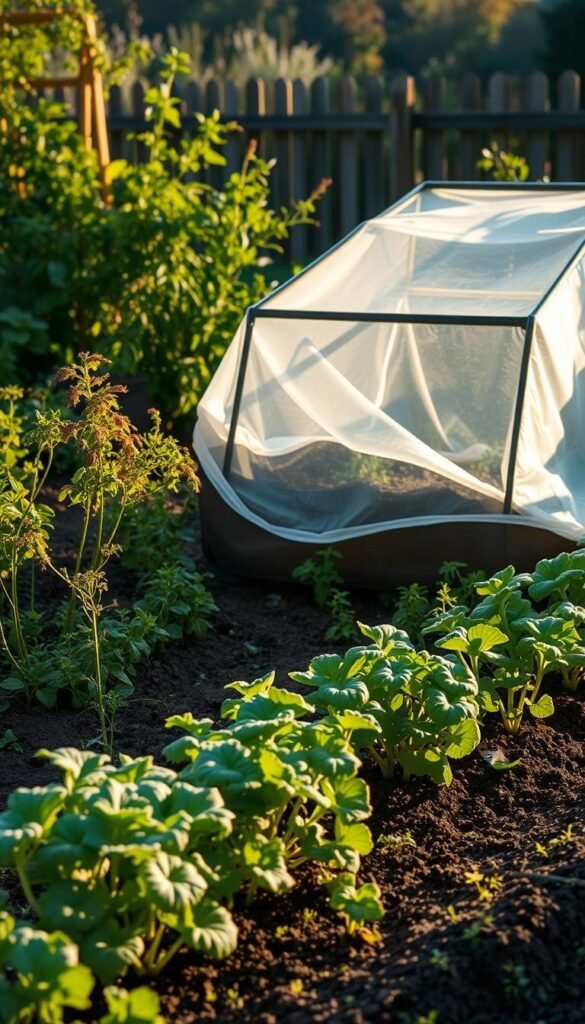
Protecting your crops from icy blasts starts with smart material choices. Breathable fabrics and mesh barriers create microclimates that buffer against sudden temperature drops. These tools work best when paired with proper setup—a balance of insulation and airflow.
Using Fabric and Mesh for Temperature Control
Lightweight row covers (0.5–1.5 oz) shield plants while letting 85% of sunlight through. For windy areas, opt for knitted mesh—it reduces wind speed by 50% without trapping excess heat. Drape materials over hoops to prevent direct contact with leaves.
Check covers midday. If temperatures rise above 75°F, lift edges to release hot air. University trials show this prevents scorching while maintaining 5–10°F warmth at night.
| Material | Frost Protection | Wind Reduction |
|---|---|---|
| Spunbonded Polyester | Down to 28°F | 30% |
| Knitted Mesh | Down to 32°F | 50% |
| Floating Fabric | Down to 24°F | 20% |
Proper Anchoring and Ventilation Tips
Secure covers with U-shaped pins or sandbags every 3 feet. For raised beds, clip fabric to wooden edges using binder clips. This stops gusts from flipping your protection system.
Open ends during sunny days to refresh air flow. Close covers 2 hours before sunset to trap warmth. In spring, remove barriers once nighttime lows stay above 45°F for two weeks.
Rotate covers monthly to prevent wear spots. Store them dry to avoid mold—your garden gear will last 3–5 seasons with basic care.
Soil Warming and Early Planting Strategies
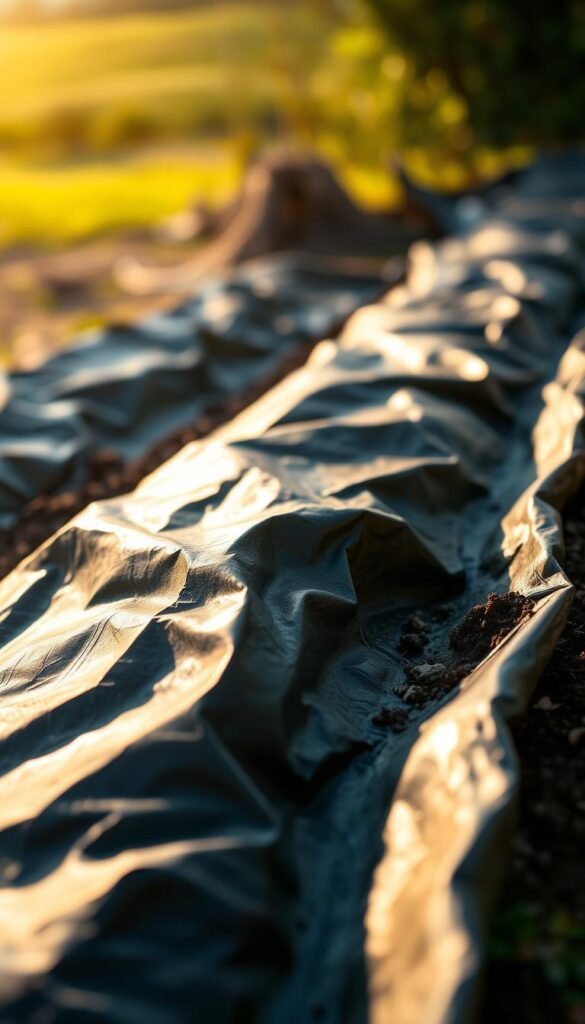
Early soil warmth kickstarts root growth and accelerates crop maturity. Black plastic mulch acts like a solar sponge, absorbing daytime heat and transferring it downward. This simple trick lets you plant cool-weather crops 2-3 weeks earlier than uncovered beds.
Employing Black Plastic Mulch for Faster Soil Warm-Up
Lay sheets over prepared beds 14 days before seeding. The plastic raises soil temps by 5-15°F—enough to wake dormant microbes. Punch holes for transplants once nighttime lows stay above 40°F. Leave edges loose to allow air circulation and prevent overheating.
Remove mulch gradually as plants establish. Start by cutting slits around stems, then peel back sections over 7-10 days. This slow exposure prevents shock while encouraging deep root growth. University trials show this method boosts lettuce yields by 30% in early spring.
| Mulch Type | Temp Increase | Ideal Duration |
|---|---|---|
| Black Plastic | 8-12°F | 4-6 weeks |
| Clear Plastic | 10-15°F | 2-3 weeks |
| Landscape Fabric | 3-5°F | Entire season |
Pair plastic with cold frames for maximum effect. Remove covers during sunny afternoons to harden plants naturally. By staggering plantings and mulch removal dates, you’ll harvest spinach into early summer and replant for fall.
Season Extension Options for Cooler and Warmer Weather
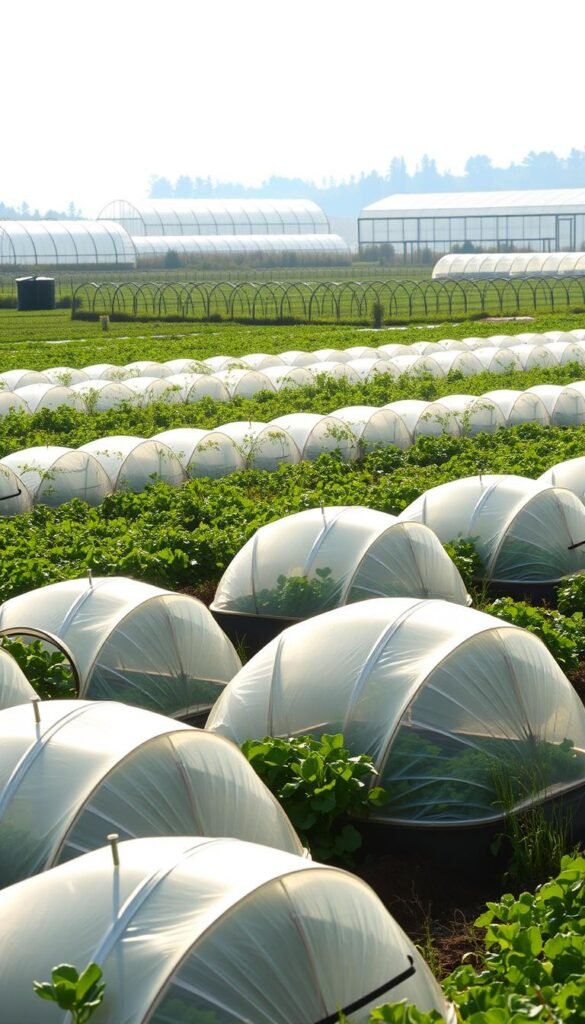
Imagine harvesting strawberries weeks before your last frost date or growing basil through October’s chill. Advanced structures like low tunnels and greenhouses adapt to shifting temperatures, giving your garden climate flexibility. These tools create micro-environments where crops flourish despite outdoor extremes.
Exploring Low Tunnels and High Tunnels
Low tunnels use hoops and breathable fabric to shield plants from frost. They’re ideal for early spring lettuce or fall carrots, adding 4-6 weeks to your growing season. High tunnels—taller versions with plastic sheeting—allow walking space and suit tomatoes or peppers.
| Feature | Low Tunnel | High Tunnel |
|---|---|---|
| Height | 2-3 ft | 6-8 ft |
| Cost | $0.50/sq ft | $2.50/sq ft |
| Best For | Leafy greens | Vining crops |
Penn State researchers found high tunnels raise soil temps by 10-15°F, perfect for warm-weather crops. Both options use air circulation to prevent mold while trapping heat.
Adapting With Greenhouses and Alternative Structures
Portable greenhouses offer versatility for small spaces. Zip-up models protect seedlings in spring, then store easily. For year-round use, pair them with plastic mulch to boost root zone warmth.
University extensions recommend:
- Opening vents when temps hit 75°F
- Using shade cloth during summer heat waves
- Anchoring frames with rebar in windy areas
These structures help you control conditions without constant effort. One Iowa gardener grows citrus in winter using a heated greenhouse—proof that creativity unlocks endless growing seasons.
Practical Tips for Daily Garden Management
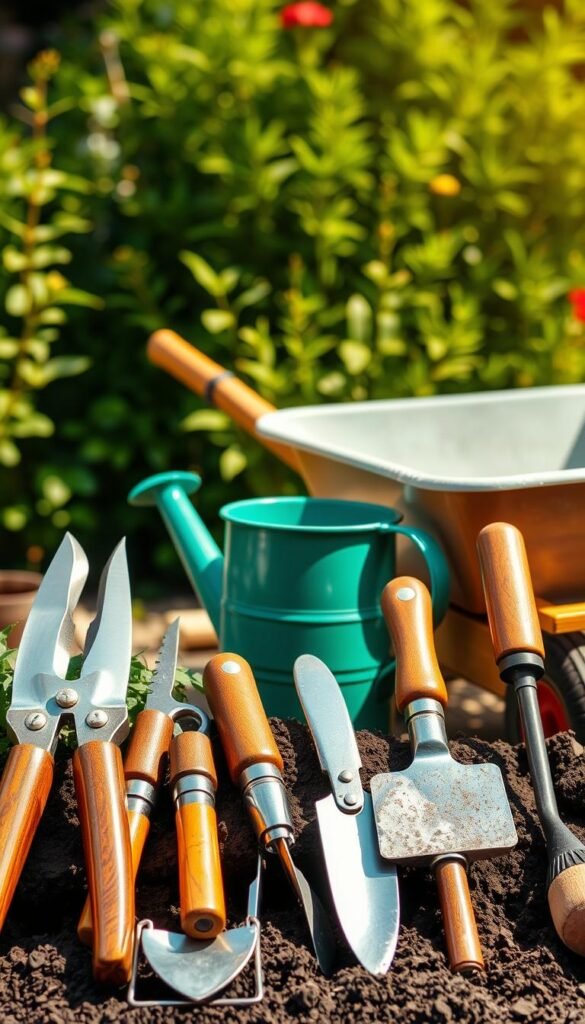
Keeping your garden thriving requires daily attention to its microclimate. Small adjustments to protection systems and airflow can mean the difference between crispy kale and wilted leaves. Start each morning with a quick walkthrough—your plants will show you what they need.
Smart Climate Tracking Made Simple
Place wireless thermometers at both ends of your low tunnels to monitor temperature swings. Aim for 65-75°F during the day and above 40°F at night. If readings spike past 80°F, roll up the fabric covers halfway for instant air circulation.
Check these tools every 2-3 hours in spring and fall when weather shifts rapidly. University trials recommend automated vent openers for row covers—they react faster than manual checks during busy weeks.
| Tool | Best Use | Response Time |
|---|---|---|
| Dial Thermometer | Soil Checks | 5 minutes |
| Digital Sensor | Air Monitoring | Real-time |
| Vent Opener | Heat Relief | 30 seconds |
Anchor low tunnel edges with metal stakes to withstand gusts. For side ventilation, lift covers 6-8 inches during sunny afternoons. Close them before dusk to trap residual warmth in the soil.
Rotate covers weekly to prevent wear patterns. Use a soft brush to remove debris—your garden gear lasts longer when cleaned regularly. With these habits, you’ll master microclimates in just 15 minutes a day.
Wrapping Up Your Extended Growing Season Experience
Your garden’s potential stretches far beyond traditional growing months with the right approach. By combining cold frames, breathable row covers, and adaptable structures, you create a resilient system that thrives in shifting conditions. These tools work with your soil’s natural warmth, not against it—a game-changer for year-round harvests.
Think of your garden as a layered shield. Lightweight fabrics guard tender plants during spring chills, while sturdier greenhouse setups fend off winter’s bite. Pairing these with smart airflow management ensures balanced temperatures, whether you’re growing leafy greens or hearty root crops.
Your local climate dictates the best mix of strategies. In cooler zones, focus on insulating low tunnels and black plastic mulch. Warmer regions might prioritize shade cloth and vented structures. Either way, regular checks for air circulation and soil moisture keep crops happy.
Ready to redefine success? Start small—try a row cover on fall spinach or a portable greenhouse for early tomatoes. Track what works, tweak as needed, and watch your gardening calendar expand. With each season, you’ll grow more confident—and your harvests will prove it.
